Buck Rogers and the atomic education of America
By John Mecklin | November 13, 2012
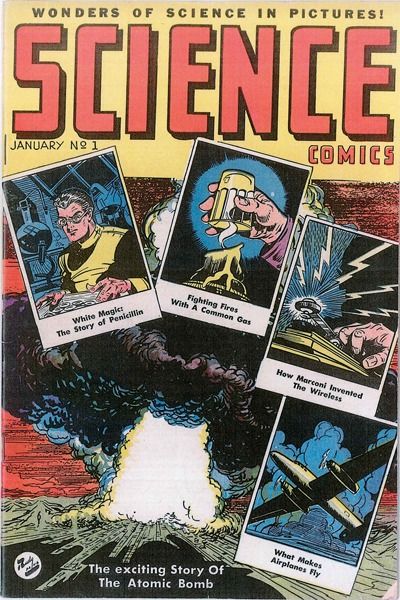
Atomic Comics: Cartoonists Confront the Nuclear World
By Ferenc Morton Szasz
University of Nevada Press
$34.95
Atomic Comics: Cartoonists Confront the Nuclear World
By Ferenc Morton Szasz
University of Nevada Press
$34.95
After being discharged from the Air Service at the end of the Great War, Buck Rogers was hired by the American Radioactive Gas Corporation as an inspector; while investigating a mine, he was overcome by (what else?) radioactive gas, and it preserved him for some 500 years. When he woke in the year 2430, Rogers discovered a world filled with villains whom he regularly bested in a syndicated comic strip, "Buck Rogers in the 25th Century A.D." That strip, which began in 1929, led to nearly four decades of Buck Rogers pop culture prominence, not just in the comics, but on radio, in books, and at the movies. The Buck Rogers franchise was so popular it spawned imitations, contemporary and far in the future, from Flash Gordon to Star Wars.
As the late historian Ferenc Morton Szasz argues in his charming and sophisticated book Atomic Comics: Cartoonists Confront the Nuclear World, the Buck Rogers stories also constituted the classroom in which many Americans of the 1930s and early '40s learned about the amazing new world of atomic energy. For instance, the Daisy manufacturing company (best known for its BB guns) produced a Buck Rogers Atomic Disintegrator Pistol, which capitalized on the comic saga's many Depression-era atomic references, including an adventure during which Buck commands: "Drop Atomic bombs. Then we'll land and mop up." Of course, whatever Buck Rogers did, Flash Gordon copied, adding flair. "In a 1940 daily strip," Szasz writes, "(Flash's girlfriend) Dale Arden is grabbed by a man-eating Octoclaw. To save her, Flash rips the sole power source from the land/sea rocket car and ‘blasts the monster with atomic power.'"
Buck Rogers and Flash Gordon were certainly not the only means by which ordinary Americans learned their nuclear lessons in the years before Trinity; there were science fiction books and magazines and, on the science-fact side, a significant contingent of journalists who dealt seriously with subatomic matters. But before Hiroshima, Szasz argues, Rogers and Gordon were by far the most popular portrayers of this new world, which included not only the danger of then-still-imaginary atomic bombs, but also a vague, immense potential for a glorious, leisure-filled future: "[O]verall, the weapons could be controlled, and the promised energy seemed potentially limitless. In other words, the 'atomic future' would surely, somehow, work out for the best."
One might view Atomic Comics through many lenses. To some degree, the book fits in the "researcher studies pop culture" category, but it is much too entertainingly — even, at times, wryly — written to consign to the academic corner of the library. It is not per se a book for comics enthusiasts, either, although I suspect many a fan will be fascinated with its range. Even dedicated obscurantists will likely find something new in a book that includes both the wide-eyed Science Comics: Wonders of Science in Pictures ("The Exciting Story of the Atomic Bomb," January 1946) and Leonard Rifas's razor-edged All-Atomic Comics, which enlivened the 1970s by asking this question on the cover — "Is Nuclear Power the Answer?" — and then immediately answering it: "Kid I'd Bet Your Life on It!"
CAPTION 1: The main story in the January 1946 issue of Science Comics looked at atomic history and the future of atomic energy.
Atomic Comics is, however, primarily a double-barreled book of history, written by a professional historian — before his death in 2010 of leukemia, Szasz taught for 43 years at the University of New Mexico, where he focused on the history of American religion, World War II and the Atomic Age — who grew up on Batman, Green Arrow, Sub-Mariner, and Mad magazine. And Atomic Comics is indeed a serious book, just not a dull one. It tells the story of the Atomic Age through the comic books that made its arcane science and looming dangers comprehensible to the masses, along the way raising a provocative question: Could pop culture be the most effective method of informing the public about complex threats to human existence?
An illustrated history. As secretive fission research continued and the United States entered World War II, Buck Rogers and Flash Gordon were joined in their sometimes-atomic adventures by a phalanx of heroes who inhabited a new medium, the comic book: Superman, Batman, the Flash, Captain Marvel and host of less-famous super-powered protagonists. These and a regiment of more specifically patriotic heroes (the Flag, the Shield, Minuteman, Captain Freedom, and so on) were quickly drafted into the illustrated fight against Nazi Germany and Imperial Japan. They brought their atomic themes with them.
Between 1939 and the Hiroshima bombing, Szasz writes, some 40 comic books contained atomic stories, many of them doozies. In 1940, Spacehawk could already fly a million miles an hour "because he had tapped the secret of 'applying atomic power.'" In 1941, "the Human Torch destroyed an 'atom gun,' but not before it demolished an island, a building, and the Statue of Liberty with a single burst of power."
In the early years of World War II, the US Office of Censorship, fearful that Nazi Germany would learn of the US research efforts that culminated in the Manhattan Project, enforced a virtual blackout on press coverage of atomic matters, Szasz writes: "Among the forbidden subjects were the terms 'atomic power,' 'cyclotrons,' 'betatrons,' 'atomic fission,' 'atom smashing,' and any reference to basic atomic research. Overnight, the science writers who had been covering U-235 and U-238 switched to other topics."
Eventually, the security apparatus even turned its gimlet eye to Superman. The censors were troubled by a 1944 story about Lex Luthor's atomic bomb, which apparently was too close in size to the actual plutonium core of the Fat Man bomb for governmental comfort. Then, in the spring of 1945, a cyclotron set to bombard Superman with three million electron volts of particles going a billion miles an hour was seen as a potential security risk. The syndicate that distributed Superman agreed to keep atomic-related comics out of newspapers for the duration.
Still, the comics had been dealing with atomic beams, weapons, and propulsion through most of the war, and if these comic strips and books were wrong about the details, Szasz notes, "the fact that the American public instantly grasped the basic outlines of the atomic age almost surely has its roots in the larger-than-life adventures of Superman, Buck Rogers, Flash Gordon, and Mickey Mouse, and well as other long-forgotten characters from that 'loose and baggy creature' of American popular culture."
Atomic comics turn political. America's relationship with things atomic changed after World War II, and so did the comics' treatment of nuclear storylines. Atomic Comics is perhaps at its best when it addresses the interaction between the real and fantasy nuclear worlds during the Cold War. In the wake of Hiroshima and Nagasaki, scientists and journalists made heartfelt attempts to explain the nuclear paradox: Nuclear weapons could destroy the Earth, but nuclear power could potentially power it at extremely low cost.
Between 1945 and the early 1960s, Szasz argues, the comic book industry dealt with the atomic realm in three general stages: First, nonfiction illustrated publications like Science Comics and True Comics instructed the youth of America in the proper use of the power of the atom (leading, among many stories, to the 1949 classic, "Dagwood Splits the Atom," in which Dagwood and his wife Blondie shrink to quantum size to explain fission to, among other interested observers, Popeye).
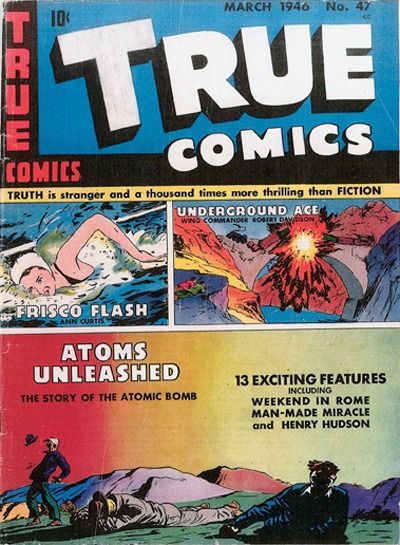
CAPTION 2: In March 1946, True Comics featured a story on the use of atomic energy to fight cancer. But the comics quickly moved away from factual education, first creating a series of unmistakably atomic heroes — including Atomic Man, Atomic Thunderbolt, and Atoman — that didn't capture the public's imagination, and then returning to what the comics do best.
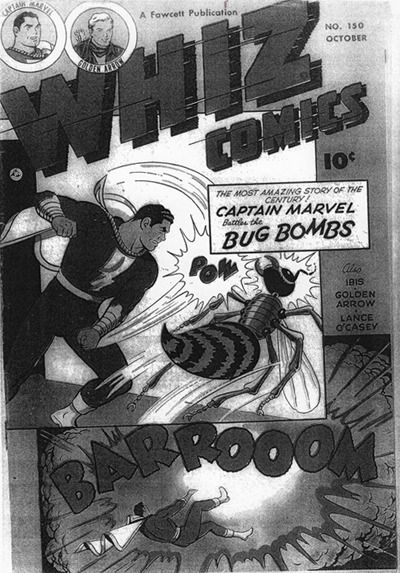
CAPTION 3: In 1952, Captain Marvel tried to get atomic-weapons-wielding bugs to make peace through the UN-like organization United Insects.
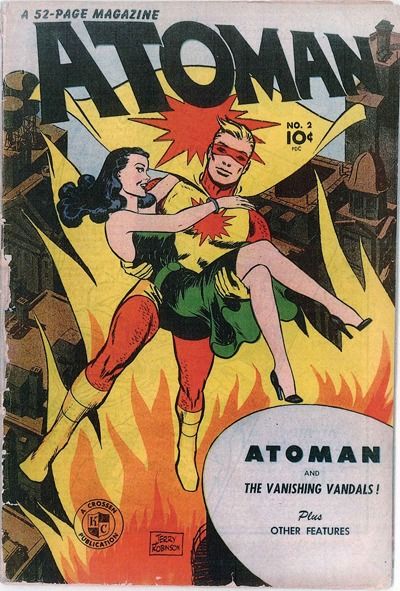
CAPTION 4: Atoman lasted only two issues before folding in 1946.
Eventually, of course, the 1960s came into flower, and the era — with all its anti-war, anti-authority, and pro-expanded consciousness themes — was reflected none too subtly in comics like Hydrogen Bomb and Biochemical Warfare funnies and Howard the Duck, the latter of which borrowed a Robert Crumb character, Greedy Killerwatt, and had him parody a song by Reddy Kilowatt, the longtime cartoon spokesman for the electric power industry, in this fashion:
I am Greedy Killerwatt
If you want Nukes I got a lot
The Stuff I push is really hot,
The Power of Tomorrow
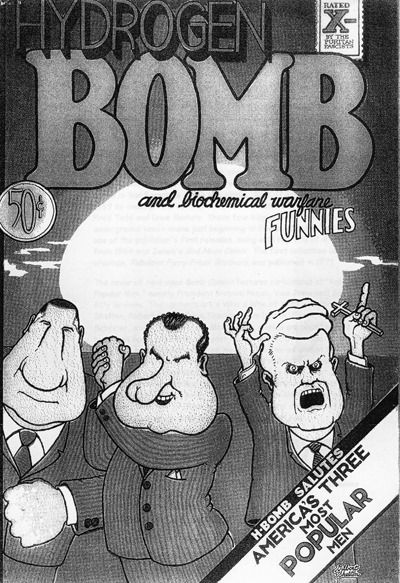
CAPTION 5: Hydrogen Bomb and Biochemical Warfare Funnies satirized the three most "popular" men of 1970 — then-Vice President Spiro Agnew, then-President Richard Nixon, and evangelist Billy Graham.
Beyond its thorough dissection of American underground comics, Atomic Comics deals comprehensively with Japanese anti-war comics, particularly Keiji Nakazawa's Barefoot Gen, a manga version of Hiroshima from a victim's point of view. (A 6-year-old Nakazawa survived the bombing with minor injuries but lost his father, sister, and brother). For those not intimately familiar with Japanese pop-culture responses to Hiroshima and Nagasaki, the Barefoot Gen section of Atomic Comics offers revelation upon revelation, and an interesting conclusion: "The European and American cartoonists meant well, but their Japanese counterparts spoke from the heart when they constructed manga tales of nuclear power or crafted stories of the atomic bomb; they knew exactly what they were doing. And, unlike their US or European colleagues, they succeeded in placing the complex story of nuclear energy at the very heart of their culture."
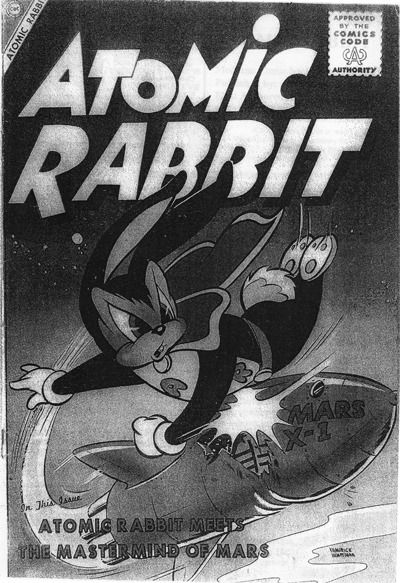
CAPTION 6: Yes, there was even an Atomic Rabbit.
As Szasz notes, it is difficult to prove precisely what impact popular culture has had on a societal pursuit as ambiguous, complex, and frightening as the use of nuclear power. Arms control negotiators probably haven't looked to Spider-Man, Atomic Rabbit (yes, there was one), or even Buck Rogers for guidance. Yet, as Szasz also concludes, comic artists and writers have produced billions of images and stories related to nuclear matters. They must have been some effect on society, and for all their variety over seven decades, the atomic comics have all essentially agreed on one thing: the need to prevent post-Hiroshima and Nagasaki nuclear warfare. Atomic-themed comic books may not have been the primary reason the Cold War did not turn hot, but they certainly helped push the culture of existentially threatened times toward peace, and, for that reason, they are worthy of continued study by historians, national security experts, advocates for world peace, climate change scientists and activists, and children of all ages.
Together, we make the world safer.
The Bulletin elevates expert voices above the noise. But as an independent nonprofit organization, our operations depend on the support of readers like you. Help us continue to deliver quality journalism that holds leaders accountable. Your support of our work at any level is important. In return, we promise our coverage will be understandable, influential, vigilant, solution-oriented, and fair-minded. Together we can make a difference.
Topics: Book Review, Nuclear Weapons














